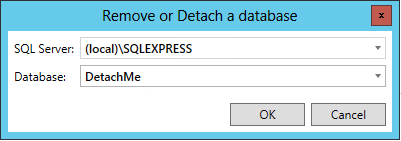Database Management
The Database Management section of the Project ribbon in the Workbench allows users to perform a number of database-related actions.
Database Management Section of the Project Ribbon in the Workbench

Configure Database
-
Click on Configure Database to install application configurations in a database. This opens the Install application configuration in a database window, shown below.
Install applications configuration in a database Window

-
In the Connection Settings section of the window, select the SQL Server and Database from the pulldown menus. You can also opt to Backup (the) database before the installation.
-
You can opt to expand the File Size section of the window and then set the database's Initial Size (in megabytes), File Growth (in either megabytes or percentage) and (optionally) Maximum Size (in megabytes). In addition, you can also set a Custom Location for the database. If selected, you can then enter a location in the text entry field or click on the
 button
to set your preferred location.
button
to set your preferred location. -
Next, you can also opt to provide the same information for Log Size, including an optional Custom Location for the log file.
-
Click Next to continue. You will then see the following secondary options.
Secondary Options Within the Install applications configuration in a database Window

-
You can decide which of the listed applications (via their Application Names) that you would like to Install/Overwrite within your newly configured database or if you would like to include Sample Data within those applications.
-
Clicking the Show version details checkbox provides additional info, including Supported Version, and Current Version.
-
Click Install to complete your selected database configuration.
Upgrade Database
- Click on Upgrade Database to upgrade one or more configurations. The Upgrade one or more applications window, shown below, appears.
Upgrade one or more applications Window

-
In the Connection Settings section of the window, use the pulldown menus to select your SQL Server and the Database to upgrade.
-
If your selected items require upgrades, you will see the information (Application Name, Supported Version and Current Version) in the bottom of the window.
-
Click on Upgrade to complete the process.
Attach Database
- Click on Attach Database to attach an existing database. The Attach a database window, shown below, appears.
Attach a database Window

-
Use the top pulldown menu to select your SQL Server.
-
Enter a file name to attach or click on the
 button to open a file browser
to locate your preferred database file.
button to open a file browser
to locate your preferred database file. -
Once you have selected your database file to attach, you can provide a name for it, in the Attach as text entry field, as you want it to appear in the Workbench.
-
Click OK to complete the process.
Delete Database
- Click on Delete Database to delete a database from the selected SQL server. The Remove or Detach a database window, shown below, appear.
Remove or Detach a database Window

-
Use the pulldown menus to select the SQL Server and the Database that you wish to delete.
-
Click OK to complete the process.
Detach Database
- Click on Detach Database to detach a database from the selected SQL server. The Remove or Detach a database window, shown below, appear.
Remove or Detach a database Window

-
Use the pulldown menus to select the SQL Server and the Database that you wish to detach.
-
Click OK to complete the process.
Backup Database
- Click on Backup Database to create a backup of a selected database. The Backup a database window, shown below, appears.
Backup a database Window

-
Use pulldown menus to select the SQL Server and the Database that you wish to back up.
-
Next, you can provide a Backup Name in the text entry field.
-
Then, you can provide a Backup Description in the last text entry field. Note that if you do not specify a Backup Name and Backup Description, the server will automatically generate this information.
-
Click OK to complete the process.
Restore Database
- Click on Restore Database to restore a backup of a selected database.
Restore a database Window

- Use the pulldown menus to select the SQL Server and the Database you wish to restore.
- Once you have selected these items,
you can optionally decide to click on the
 button,
in order to download the database's restore points. This will automatically
populate the section below in the Created
On, Name
and Description
fields.
button,
in order to download the database's restore points. This will automatically
populate the section below in the Created
On, Name
and Description
fields.
- Click OK to complete the process.
See Also: